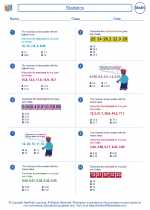Bar Chart Study Guide
A bar chart is a graphical representation of data in which the length of bars represents the frequency or intensity of the variable being measured. It is a useful way to display and compare the numerical values or frequencies of different categories or groups.
To create a bar chart, follow these steps:
- Identify the categories or groups you want to compare.
- Label the x-axis with the categories or groups.
- Label the y-axis with the numerical values or frequencies.
- Draw bars for each category, with the height of each bar corresponding to the value it represents.
- Ensure the bars are equally spaced and of uniform width.
When interpreting a bar chart, consider the following:
- Compare the heights of the bars to understand the relative differences in values or frequencies.
- Look for trends or patterns in the data, such as which category has the highest or lowest value.
- Use the chart to make comparisons and draw conclusions about the data being represented.
Bar charts are useful for displaying categorical data and are often used in various fields such as statistics, business, and social sciences to visually represent and analyze data.
.◂Math Worksheets and Study Guides Fifth Grade. Statistics
Study Guide Statistics
Statistics  Worksheet/Answer key
Worksheet/Answer key Statistics
Statistics  Worksheet/Answer key
Worksheet/Answer key Statistics
Statistics  Worksheet/Answer key
Worksheet/Answer key Statistics
Statistics 

 Worksheet/Answer key
Worksheet/Answer key
 Worksheet/Answer key
Worksheet/Answer key
 Worksheet/Answer key
Worksheet/Answer key

The resources above cover the following skills:
Data Analysis and Probability (NCTM)
Select and use appropriate statistical methods to analyze data.
Use measures of center, focusing on the median, and understand what each does and does not indicate about the data set.